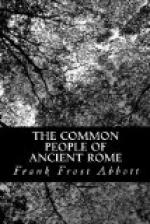Common to the ancient and the modern city are expenditures for the construction and maintenance of public buildings, sewers, aqueducts, and streets, but with these items the parallelism ends. The ancient objects of expenditure which find no place in the budget of an American town are the repair of the town walls, the maintenance of public worship, the support of the baths, the sale of grain at a low price, and the giving of games and theatrical performances. It is very clear that the ancient legislator made certain provisions for the physical and spiritual welfare of his fellow citizens which find little or no place in our municipal arrangements to-day. If, among the sums spent for the various objects mentioned above, we compare the amounts set apart for religion and for the baths, we may come to the conclusion that the Roman read the old saying, “Cleanliness is next to godliness” in the amended form “Cleanliness is next above godliness.” No city in the Empire seems to have been too small or too poor to possess public baths, and how large an item of annual expense their care was is clear from the fact that an article of the Theodosian code provided that cities should spend at least one-third of their incomes on the heating of the baths and the repair of the walls. The great idle population of the city of Rome had to be provided with food at public expense. Otherwise riot and disorder would have followed, but in the towns the situation was not so threatening, and probably furnishing grain to the people did not constitute a regular item of expense. So far as public entertainments were concerned, the remains of theatres and amphitheatres in Pompeii, Fiesole, Aries, Orange, and at many other places to-day furnish us visible evidence of the large sums which ancient towns must have spent on plays and gladiatorial games. In the city of Rome in the fourth century, there were one hundred and seventy-five days on which performances were given in the theatres, arenas, and amphitheatres.
We have been looking at the items which were peculiar to the ancient budget. Those which are missing from it are still more indicative, if possible, of differences between Roman character and modes of life and those of to-day. Provision was rarely made for schools, museums, libraries, hospitals, almshouses, or for the lighting of streets. No salaries were paid to city officials; no expenditure was made for




